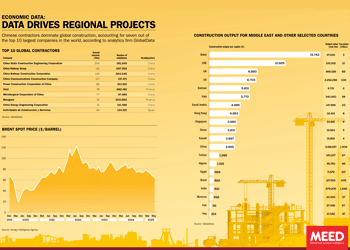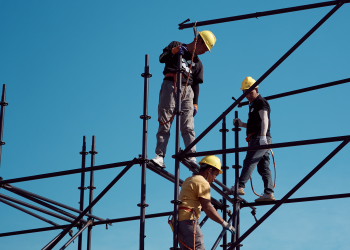EuroChem eyes Mena food security opportunity
24 August 2023

EuroChem Group is one of the top three global fertiliser producers and is one of only three firms worldwide with manufacturing capacity in all three primary nutrient groups: nitrogen, phosphates and potash.
Headquartered in Switzerland, EuroChem operates manufacturing facilities in Belgium, Brazil, Kazakhstan, Lithuania and Russia, employing over 27,000 people in 40 countries. Its products are exported to more than 100 countries.
In the wake of the Russia-Ukraine war, however, the company has found itself caught in the net of economic sanctions imposed by the EU and its member states on companies doing business in Russia.
 The financial sanctions, which included the freezing of its bank accounts, caused EuroChem to look to set up a branch outside Europe from which it could continue to do business with its customers. The company opened a trading outpost in Dubai earlier this year.
The financial sanctions, which included the freezing of its bank accounts, caused EuroChem to look to set up a branch outside Europe from which it could continue to do business with its customers. The company opened a trading outpost in Dubai earlier this year.
“Recently, we have moved some of our trading functions to Dubai to be closer to our clients in Asia, Africa and the Indian subcontinent. These regions present great growth opportunities for our business and will add to our strong market presence in Europe and the Americas,” says Samir Brikho, executive chairman and CEO of EuroChem Group.
“While EuroChem remains a Swiss company with global operations across most major agricultural markets, establishing this new branch in the Middle East will position us to expand our operations in the region, as well as across Africa and Asia.”
Regional strategy
EuroChem is looking to tap into the opportunities presented by the efforts of countries in the Middle East and North Africa (Mena) region to address food security challenges.
“We believe the region presents production and sales opportunities that are aligned to our long-term growth ambitions. We are discussing partnerships and investments that could further bolster our regional presence,” Brikho says.
“We know the potential is there. In 2022, EuroChem sold almost 140,000 tonnes of fertilisers and industrial products to the Mena region, including more than 40,000 tonnes sold to the Middle East,” he says, adding that the firm is also committed to making a contribution to food security in Africa.
“We recently appointed a head of strategy for Africa who will help us to identify opportunities for investment on the African continent.”
The availability of commercially-feasible natural gas as a feedstock is one of the key criteria for fertiliser producers such as EuroChem to consider when investing in output expansion projects.
“Gas is an essential feedstock for the production of nitrogen fertilisers and an important input for phosphate fertilisers. Both fertiliser types are produced by EuroChem. As with all input materials, the availability of natural gas, at the right price and in proximity to our operations, is essential for our production and business model,” Brikho says.
When it comes to potentially expanding EuroChem’s business in the UAE beyond the sales branch, Brikho says: “The UAE is perfectly positioned as a major commercial, manufacturing, logistics and export hub with more than 40 multidisciplinary freezones.
“However, fertiliser production is reliant on proximity to its raw material supply chain of ammonia, natural gas, phosphate rock and potash.
“At present, we have no plans to invest in production facilities in the UAE, but if we identify opportunities that make business sense, then it will most certainly be considered.”
Addressing food security
Food security is a growing global challenge, and for the Mena region, which is primarily an importer of food products, the challenge is steep.
The situation has been made worse by rising global inflation spiking food prices, especially those of agricultural produce.
The high cost of fertilisers for farmers has played a part in pushing food prices even higher in recent months, mainly as a consequence of the Russia-Ukraine war.
“The fertiliser industry has faced multiple sanctions-related obstacles that have disrupted production, access to finance, logistics and supply chain networks. Taken together, this had a devastating impact on global production last year,” says Brikho.
The fertiliser industry has faced multiple sanctions-related obstacles that have disrupted production
“In Europe in particular, the inconsistent application of EU policies relating to sanctions had profound effects that curtailed production and caused shutdowns of European fertiliser production facilities. This led to reduced supply and availability and drove up costs.”
During last year’s peak, fertiliser prices increased by up to 300 per cent compared to 2021, affecting farmers globally, he continues.
“Now, we are seeing the longer-term impacts this has had on food availability and prices globally, where it is always those who can least afford it who suffer the most.”
EuroChem is doing its part to address food security and challenge the issue of rising costs, the CEO says.
“At EuroChem, we are united with international farmers and those from regions such as Mena that rely heavily on food and fertiliser imports.”
International governments need to put policies in place that "protect the global agricultural supply chain from the types of disruption and volatility brought on by geopolitical events and sanctions that we have experienced over the last year”, Brikho adds.
“We have to work together to mitigate against shocks that continue to impact food production, availability and the price of feeding our communities – and in particular those communities in poorer countries that are the most vulnerable.”
Main image: EuroChem's facilities in Antwerp, Belgium
Exclusive from Meed
-
 June 2025: Data drives regional projects
June 2025: Data drives regional projects30 June 2025
-
 UAE-Turkiye financial links strengthen
UAE-Turkiye financial links strengthen30 June 2025
-

-
 Iraq approves Basra housing project
Iraq approves Basra housing project30 June 2025
-
 Meraas announces Dubai City Walk expansion
Meraas announces Dubai City Walk expansion30 June 2025
All of this is only 1% of what MEED.com has to offer
Subscribe now and unlock all the 153,671 articles on MEED.com
- All the latest news, data, and market intelligence across MENA at your fingerprints
- First-hand updates and inside information on projects, clients and competitors that matter to you
- 20 years' archive of information, data, and news for you to access at your convenience
- Strategize to succeed and minimise risks with timely analysis of current and future market trends

Related Articles
-
 June 2025: Data drives regional projects
June 2025: Data drives regional projects30 June 2025
Click here to download the PDF
Includes: Top 10 Global Contractors | Brent Spot Price | Construction output
To see previous issues of MEED Business Review, please click herehttps://image.digitalinsightresearch.in/uploads/NewsArticle/14171168/main.gif -
 UAE-Turkiye financial links strengthen
UAE-Turkiye financial links strengthen30 June 2025
 This package on UAE-Turkiye relations also includes:
This package on UAE-Turkiye relations also includes:> UAE-Turkiye trade gains momentum
> Turkiye’s Kalyon goes global

Turkish bank DenizBank is one of Turkiye’s leading private banks and, as a wholly owned subsidiary of Emirates NBD since 2019, it is playing a leading role in developing business links between the UAE and Turkiye.
Recep Bastug, who was appointed as DenizBank’s CEO in 2024, says there is great potential for trade between the two countries.
“Turkiye is a growing country,” he says. “We’ve had volatility over the past five years, but the Turkiye economy and the banking sector have been able to manage those periods successfully.”
Having spent years with international institutions such as BBVA, Bastug has vast experience in the banking sector. “Turkish banks, especially private ones like DenizBank, are very successful. In terms of capital, balance sheet structure and digital transformation, we are in a strong position,” he says.
 Solid fundamentals
Solid fundamentalsTurkiye’s fundamentals remain solid with a diversified export-oriented economy, a young and skilled population of 85 million, and relatively low debt levels. “We are not a highly leveraged country. Our household debt-to-GDP ratio is low. With the right policy mix, we offer high potential for foreign investors,” says Bastug.
That potential is increasingly being realised through growing engagement with the GCC and the UAE. “Turkiye’s connection with the Gulf is going up, and DenizBank is set to play a serious role in these relations. Day by day, Turkish companies are expanding their footprint in the region.”
GCC projects
Baştug says that many of these companies approach DenizBank to help facilitate their entry into Gulf markets. “Some of our clients are extremely well capitalised, but others need support for major projects. Just recently, one Turkish company announced a $3bn project in the region. We’re helping them connect with Emirates NBD and navigate the local financial landscape.”
DenizBank is actively supporting the creation of trilateral partnerships – particularly between Turkiye, the UAE and Saudi Arabia. “We see huge opportunity in forming financial strongholds across these markets, leveraging Turkiye’s contractor experience, the UAE’s capital and Saudi Arabia’s scale,” says Baştug.
DenizBank is already delivering results. “With Emirates NBD, we’ve identified 10 strategic cooperation areas, including trade finance, payments and capital markets. Thanks to this partnership, Emirates NBD has become the number one debt capital markets bank in Turkiye, even ahead of global players.”
One area of growing activity is initial public offering (IPO) participation. “We’ve launched a mutual fund that allows Turkish private banking clients to participate in IPOs from the region, including from the UAE and Saudi Arabia. It’s a diversification strategy and helps retain wealth within the group.”
Turkiye’s connection with the Gulf is going up, and DenizBank is set to play a serious role in these relations. Day by day, Turkish companies are expanding their footprint in the region
Recep Bastug, DenizBankInflation ends
Despite the current inflationary environment, Bastug says there is a clear inflection point ahead. “We expect 2027 to be a turning point. Once we exit the inflationary accounting regime [in Turkiye], DenizBank will become one of the biggest contributors to Emirates NBD’s global balance sheet. Last year, we contributed $1.2bn. In 2027, it will be significantly more.”
DenizBank is the fifth-largest private bank in Turkiye with about a 5% market share. “The largest private bank is at 13%. It’s not easy to close that gap – but we will do it. Our long-term goal, aligned with our shareholder, is to become the biggest and most successful private bank in the country.”
The bank is especially focused on agriculture, SMEs, and export financing – sectors that are deeply relevant to
Turkiye’s economic growth and to regional demand. “We are the leading agricultural bank in Turkiye, and we believe strongly in the sector’s future – both for local consumption and exports.”Regional opportunities
Bastug also sees potential for engagement beyond the GCC, including in post-conflict reconstruction. “In the past, Turkiye had strong trade volumes with Syria. Even during wartime, commercial links remained. Once a stable environment emerges, there will be opportunities – especially in infrastructure.”
While a physical branch presence is not currently being considered, DenizBank is prepared to support Turkish contractors operating in neighbouring countries. “We have the relationships and expertise to facilitate this growth. And culturally, we’re well aligned with the region – it helps make business smoother.”
As Turkiye re-establishes economic momentum and Gulf economies look to deliver on long-term visions, DenizBank is positioning itself for a more active role in the region in the future. “We are preparing the bank for the next stage, and with the backing of Emirates NBD, we’re confident in our ability to lead.”
READ MORE
> UAE-Turkiye trade gains momentum
> Turkiye’s Kalyon goes globalhttps://image.digitalinsightresearch.in/uploads/NewsArticle/14170372/main.gif -
 Multiply agrees to sell Pal Cooling to Tabreed and CVC
Multiply agrees to sell Pal Cooling to Tabreed and CVC30 June 2025
Abu Dhabi-based investment company Multiply Group has agreed to sell all of its shares in its district cooling subsidiary Pal Cooling Holding (PCH) for AED3.8bn ($1bn) to a consortium comprising Engie-backed National Central Cooling Company (Tabreed) and CVC DIF.
The transaction is still subject to regulatory approvals.
MEED exclusively reported in May that a team comprising Tabreed and CVC was holding exclusive discussions to acquire PCH.
Multiply Group initially acquired a 100% stake in PCH and its subsidiaries in July 2021.
Multiply Group has been advised by Standard Chartered and Clifford Chance. Tabreed and CVC DIF have been advised by Citi, Synergy Consulting and White & Case.
The transaction brings together two of the UAE’s leading district cooling players. PCH was founded in 2006 and operates five active district cooling plants across the UAE. The company maintains eight long-term concessions and strategic partnerships with some of the UAE’s leading real estate developers, servicing key residential, commercial and mixed-use developments – most notably on Abu Dhabi’s Reem Island.
Tabreed owns and operates 92 plants, including 76 in the UAE, five in Saudi Arabia, eight in Oman, one in Bahrain, one in India and one in Egypt, in addition to other international projects and operations.
https://image.digitalinsightresearch.in/uploads/NewsArticle/14170511/main.jpg -
 Iraq approves Basra housing project
Iraq approves Basra housing project30 June 2025
Iraq has approved plans to build a housing project in Basra that will offer about 5,000 homes in the first phase to tackle the country’s rising housing shortage.
The project, which is endorsed by Iraq’s National Investment Commission (NIC), will cover an area of about 3 square kilometres.
According to local media reports, Basra province governor Asaad Al-Idani said the project has already been awarded to a developer.
Iraq has been gradually recovering since the war. The government initially prioritised infrastructure and public housing to stimulate economic growth, improve living standards and attract foreign investment.
More recently, benefitting from higher oil prices and a period of relatively stable governance, Baghdad has expanded its focus to reconstructing and modernising the country’s deteriorating infrastructure.
The Iraqi construction market has also seen significant investments from private real estate developers from the region. In May, Egyptian real estate developer Ora Developers announced that it had started construction on the Al-Wardi residential city project, which consists of more than 100,000 residential units covering about 61 million square metres (sq m) on the southeastern side of Baghdad.
The move is the latest sign of international investors’ growing appetite for developing real estate in Iraq as part of the country’s post-war building initiatives.
Also in May, another Egyptian firm, Talaat Moustafa Group Holding, said it was in negotiations with the NIC to develop a mixed-use project. The project, which will cover an area of about 14 million sq m and will be located in the southwest of Baghdad, is expected to contain about 45,000 residential units.
The positive sentiment has been particularly buoyed by a robust 2024 budget, which allocated nearly $42bn to transport, social infrastructure and housing initiatives.
Looking ahead, Iraq’s construction industry is expected to register an annual average growth rate of 4.9% in 2025-28, supported by further investments in energy, infrastructure and housing projects, according to UK analytics firm GlobalData.
MEED’s June 2025 report on Iraq includes:
> COMMENT: Iraq maintains its pace, for now
> GOVERNMENT & ECONOMY: Iraq’s economy faces brewing storm
> OIL & GAS: Iraqi energy project value hits decade-high level
> PIPELINES: Revival of Syrian oil export route could benefit Iraq
> POWER: Iraq power sector turns a page
> CONSTRUCTION: Iraq pours billions into housing and infrastructure projects
> DATABANK: Iraq forecast dips on lower oil priceshttps://image.digitalinsightresearch.in/uploads/NewsArticle/14170011/main.png -
 Meraas announces Dubai City Walk expansion
Meraas announces Dubai City Walk expansion30 June 2025
Register for MEED’s 14-day trial access
Local real estate developer Meraas has announced the City Walk Crestlane project as it continues to expand its City Walk residential community in the Al-Wasl area of Dubai.
The City Walk Crestlane comprises two residential towers offering 198 one-, two-, three-, four- and five-bedroom units.
The project is expected to be completed and handed over by the third quarter of 2028.
Earlier this month, Meraas, which is part of Dubai Holding Real Estate, awarded a construction contract for another project at City Walk.
The local firm Naresco Contracting was awarded a AED450m ($123m) contract for the main construction works on its Central Park Plaza residential project at City Walk.
The project involves constructing two towers with 23 and 20 floors. Together, they will have 212 residential units.
In May, Meraas awarded another local firm, Al-Sahel Contracting Company, a AED300m contract for the main construction works on Elara, which is phase seven of the Madinat Jumeirah Living masterplan in Dubai.
The project involves building three residential towers with 234 apartments.
https://image.digitalinsightresearch.in/uploads/NewsArticle/14169472/main.jpg

